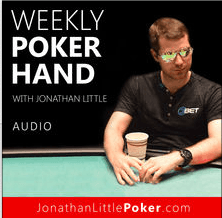
This hand illustrates a few mistakes that many players commit on a regular basis. At $2/$5 with $1,000 effective stacks, a reasonably aggressive player who plays lots of pots raised to $15 from second position at a 9-handed table. The player in third position called and then our Hero called from the hijack seat with K-Jo.
I would prefer either folding or 3-betting with K-Jo because it is often going to be dominated preflop if the initial raiser is competent. Also, it will play quite poorly after the flop when it improves to one pair, even if you have position.
The button and the big blind called as well. The flop came Qd-Js-4h. Everyone checked to Hero, who bet $65 into the $77 pot.
While I am fine with the flop bet, both for value and protection, I think checking behind in effort to control the size of the pot is my preferred play, especially if the initial raiser is capable of checking with his strong hands on this board. Also, K-J isn’t too susceptible to draws, improving the merit of checking. If instead, Hero had J-9 on T-9-4, I think betting would be better because you do not mind if your opponent folds various overcards. In this situation, the only overcard hand is A-K, and a King isn’t too bad for K-J.
Only the big blind called. The turn was the (Qd-Js-4h)-Kd. The big blind bet into Hero for $125 into the $207 pot. Hero raised to $325.
When led into on the turn, I would certainly just call because when you raise and get additional action, K-J is often in bad shape. When you are ahead, it is usually versus a premium draw that has a large number of outs. If your opponent is only leading with hands that improved on the turn, you are behind A-T, T-9, and K-Q, chopping with K-J, and losing to K-4, and K-4 is unlikely (because many players fold it to a preflop raise). I would call the turn with the intention of calling down on most safe rivers. If the big blind is the type of player who will lead with all sorts of marginal made hands, such as K-T, Q-T, and A-J, Hero should also just call because those hands are all drawing thin and will likely fold to a raise, meaning Hero will be unable to extract additional value because raising forces those hands to fold.
The big blind re-reised, pushing all-in for $1,000 total. Hero called.
When jammed on, I think reluctantly folding is the only play that makes sense. Hero is only ahead of K-4 at this point, unless the big blind is a maniac who drastically overvalues hands like K-T, which I don’t see happening too often for 200 big blinds. When someone wants to put in a ton of money, unless you have a strong hand or your opponent is a blatant maniac, you should make a prudent fold.
 This time, the big blind had T-9 for a turned straight. Hero did not improve and lost his 200 big blind stack.
This time, the big blind had T-9 for a turned straight. Hero did not improve and lost his 200 big blind stack.
If you enjoyed this type of hand analysis, you will love my podcast, Weekly Poker Hand. Each week, I review an interesting hand that I played and give my analysis on each street. If you are looking for a simple way to take your game to the next level, check it out.

really interesting analysis of this hand.. i play a lot of low money tournaments, and have seen this type of ‘mistake sequences’ often. thanks for the comments… as always, i try to learn from them
I’m glad you enjoyed it!
Great analysis, this type of advice and thought process has helped me from an average player to one who is using this type of sound judgement to improve my play greatly, thanks, Paul
Thanks! I am glad you liked it.